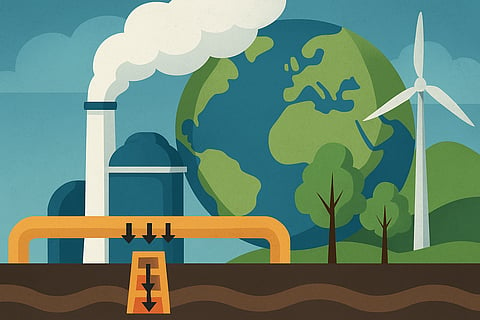Carbon Capture: The Business Case for Saving the Planet
As the world battles climate change with increasing urgency, carbon capture has emerged not only as a technological solution for reducing emissions, but also as a powerful economic tool. For businesses, it offers a pathway to net-zero targets, carbon credit generation, and reputational advantage. For the planet, it promises cleaner air and a safer future.
Let’s explore how carbon capture can align environmental responsibility with business opportunity, and why it might be the next big shift in corporate climate action.
What is Carbon Capture?
Carbon capture refers to a suite of technologies designed to trap carbon dioxide (CO₂) emissions at the source, preventing them from entering the atmosphere. These emissions are typically from:
Power plants
Industrial facilities (cement, steel, petrochemicals)
Natural gas processing
Direct air capture (DAC) machines
The captured CO₂ is then either:
Stored underground in geological formations (Carbon Capture and Storage – CCS), or
Utilized to make products like fuels, plastics, and carbonated beverages (Carbon Capture, Utilization, and Storage – CCUS)
Why It Matters for Companies
1. Meeting Net-Zero Targets
As governments and stakeholders ramp up pressure on companies to reduce emissions, carbon capture offers a practical solution—especially for industries where cutting emissions is difficult (like cement or steel).
It allows companies to:
Offset their emissions directly at the source
Reduce Scope 1 and Scope 2 emissions effectively
Avoid high penalties or regulatory setbacks
2. Generating Carbon Credits
Captured CO₂ can translate into carbon credits, which are tradable units representing one tonne of CO₂ removed or avoided. These can be:
Sold in voluntary carbon markets, earning revenue
Used to offset a company’s own emissions, particularly Scope 3 emissions
As carbon credit markets mature, early adopters in carbon capture could find themselves with valuable environmental assets—something like the “green oil” of the next decade.
3. Attracting Green Investment
ESG (Environmental, Social, and Governance) is now at the core of investment decisions. Companies that deploy carbon capture:
Gain preferential access to sustainability-linked loans
Increase attractiveness to climate-conscious investors
Strengthen brand credibility with consumers and regulators
A Boost to Carbon Credit Ecosystems
The carbon credit market, expected to reach $250 billion by 2030, needs high-integrity credits backed by measurable, verifiable carbon removals. Carbon capture projects, when independently audited, can:
Provide high-trust credits
Serve as a hedge for companies against fluctuating carbon prices
Encourage the development of carbon accounting frameworks and transparency
Countries like the U.S., Canada, and Norway are also creating policy incentives (such as tax credits like the U.S. 45Q) that encourage carbon capture projects and credit trading, making the financial case even stronger.
Environmental Payoffs: Why It’s Not Just Business
Carbon capture is not a silver bullet—but when done right, it plays a critical role in climate stabilization:
Reduces atmospheric CO₂ concentration, helping to slow global warming
Cleans up industrial processes that can’t yet go green
Buys time while renewable energy and electrification scale up
Protects biodiversity by mitigating the harmful effects of climate extremes
In fact, the IPCC (Intergovernmental Panel on Climate Change) considers carbon capture essential to meeting the 1.5°C and 2°C targets under the Paris Agreement.
Future Outlook: Integration, Innovation, and Scaling Up
The future of carbon capture lies in scale and accessibility. Here's what lies ahead:
Lower costs through innovation: Technologies like solid sorbents, biochar, and modular DAC are reducing costs
Integration with renewables: Renewable-powered DAC units can remove emissions without adding to the problem
Carbon capture hubs: Shared infrastructure for CO₂ transport and storage can boost adoption
Policy-driven acceleration: Carbon border taxes, subsidies, and ESG mandates will make carbon capture mainstream
The Takeaway: Climate Action With a Business Edge
For companies looking to stay ahead in a low-carbon economy, carbon capture is no longer just a climate responsibility—it’s a competitive advantage. It aligns environmental impact with revenue models, market positioning, and investor interest.
As global climate strategies evolve, carbon capture stands out as a bridge between profit and planet—a rare intersection where doing good and doing well are no longer mutually exclusive.
In short:
Carbon capture isn’t about saving face. It’s about saving carbon, saving money, and saving time—before it runs out.


